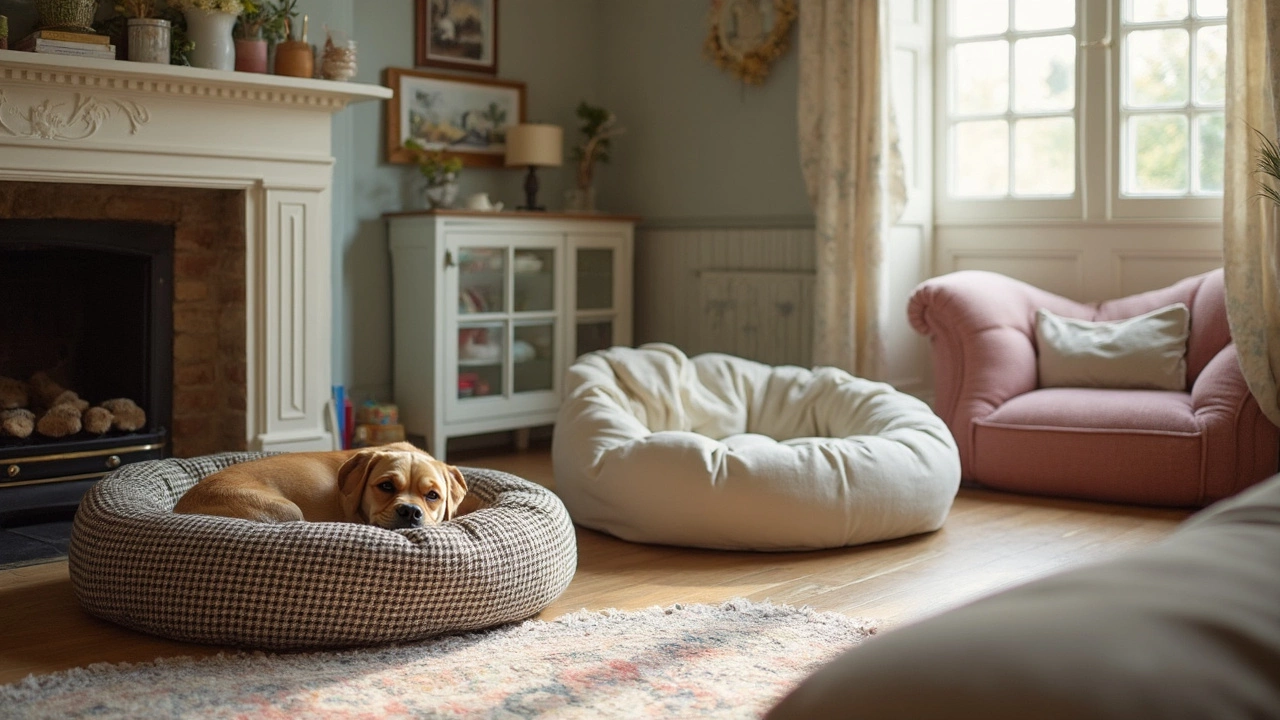If you’ve ever found your dog curled up on your socks in the laundry or squeezed into a sunbeam in the hallway, you probably wondered if your pup needs a soft spot in every room. Dogs don’t just nap—they set up camp wherever you are. That alone makes a lot of pet parents ask, should their dog really have a bed in every room?
Right away, the answer isn’t as simple as you’d think. Some dogs follow their humans like shadows—maybe you can’t even take a shower without company. If your dog fits that description, having more than one dog bed isn’t just a luxury for them—it might save your furniture, your socks, and maybe even your sanity.
But then there’s the real question: does spreading dog beds from the kitchen to the home office actually help your dog's comfort, or will Fido just pick the same favorite corner every single time? And what about cleaning, cost, or taking up too much space?
Think about your household rhythm. If your family hangs out between the living room and home office, but your dog spends half the morning waiting by your feet, it may be time to re-think your dog bed strategy. Let’s cut through the confusion and walk through what works for real homes and real dogs.
- Why Dogs Crave Their Own Space
- Pros and Cons of Multiple Dog Beds
- Choosing Where and What Type of Bed
- Real-World Tips for a Happy Dog and Tidy Home
Why Dogs Crave Their Own Space
Ever notice how your dog circles, scratches, and arranges blankets before finally flopping down? That behavior goes way back—wild dogs and wolves did the same to create a safe spot for rest and to mark territory. Modern dogs still feel the urge for a personal spot where they feel secure.
Having a dedicated place to sleep isn’t just about comfort. Vets say pups with their own bed are less likely to develop joint problems or pressure sores, especially as they age. In fact, dogs that constantly sleep on hard floors or cold surfaces might struggle with sore elbows, hips, or overall stiffness.
On top of health, a dog bed acts like a home base. If you have kids or lots of foot traffic, that bed is your dog’s signal to relax, not worry about what’s going on, and catch some real shut-eye. Even anxious dogs chill out faster when they have a familiar smell and spot to retreat to whenever life gets loud.
Here’s a look at how dogs behave based on where they sleep around the house:
| Location | Common Dog Behavior |
|---|---|
| Living Room | Social naps, near people, alert to activity |
| Bedroom | Deep sleep, less movement, feeling safest |
| Kitchen | Quick snoozes, stays close during meal prep |
| Random spots (floors/corners) | Restless, less quality sleep |
If your goal is to keep your furry friend off the couch, a dog bed in each busy area means your dog always has a cozy spot. You might also notice less scratching at doors, whining for attention, or surprise puddles—dogs with their own bed feel more part of the family routine.
Pros and Cons of Multiple Dog Beds
Let’s be honest—having a dog bed in every room sounds like you’re spoiling your buddy, but it’s not just about pampering. It can actually change your dog’s day-to-day life and even help out with some common problems pet owners face.
First up, the pros. Dogs—especially older ones—get achy, just like people. Hard floors can stress their joints and paws, especially for breeds like Labradors or German Shepherds that are prone to arthritis. Having more than one bed means your dog has options and won’t have to flop on cold, hard floors if they want to be close by. Plus, spreading out beds can help with temperature control. In summer, dogs might go for a cool, shaded spot. In winter, they’ll look for something warm. Multiple beds let them pick what feels best, right when they need it.
- Saves your couch and rugs from fur, drool, and scratching
- Lowers anxiety for dogs that get stressed when alone, since they can nap near you no matter where you are
- Cuts down on constant vacuuming if your dog sticks to their beds
- Prevents “hot spots” from dogs always lying in the same dusty corner
- Helps set boundaries, keeping four paws off beds and people furniture if that’s your rule
But let’s not pretend there are no hassles. Multiple beds mean more cleaning. If your dog sheds a lot or tracks in mud, expect to do laundry regularly or vacuum dog beds more than you’d think. Plus, decent dog beds aren’t cheap; laying one in every single room can add up quickly, especially if you go for orthopedic or high-end models.
- Extra beds take up floor space and might clutter up small rooms
- Some dogs just ignore certain beds, so you could spend money on pillows that never get used
- Kids or guests might trip on dog beds in weird spots
- If you have more than one dog, fights over “the good bed” can start
According to Dr. Lisa Lippman, a respected NYC-based veterinarian,
"Multiple beds can be really beneficial for dogs with joint problems or those that always want to stay near their owners. But owners should balance comfort with practicality—sometimes, one or two well-placed beds do the trick."
The trick is to balance what makes life easy for your dog with what makes sense for your space and your wallet. Consider how many rooms your dog actually hangs out in. Sometimes, it’s about having a smart setup, not covering every inch with fluff and fabric.

Choosing Where and What Type of Bed
Picking the right spots for dog beds is all about matching your dog’s habits with how your household works. If your dog spends their time wherever you go, stick a bed in the busiest rooms—think living room, your workspace, kitchen, or even by the bed in your bedroom. Don’t bother with rooms no one uses—it’ll just become a fur magnet.
Let’s talk bed types. Not every "dog bed" fits every space or dog. Older dogs and big breeds do best on orthopedic beds, especially in places they chill for hours, like the living room or bedroom. Cozy donut beds work great for smaller dogs or as a backup bed in corners where your dog likes to curl up and watch the action. If you have a tiled kitchen or mudroom, try a waterproof or washable mat—you’ll thank yourself during shedding season.
Here’s a super quick breakdown of what matters most:
- Location matters – Watch where your dog rests naturally, then put a bed there.
- Bed size – Make sure your dog can stretch out or curl up as they like.
- Material – Older or arthritic dogs need memory foam, while puppies and chewers need tougher, chew-proof stuff.
- Ease of cleaning – Removable, washable covers make life way easier, especially if you set up multiple beds.
- Style vs. function – If you don’t want clunky beds in the living room, try low-profile or even decorative beds that fit your home vibe.
Dr. Karen Becker, a respected veterinarian, sums it up:
"A dog’s bed is more than a luxury. It’s a safe haven that reduces joint stress, supports proper sleep, and cuts down on unwanted behavior like chewing or furniture climbing."
If you like data, check out this quick summary:
| Room | Best Bed Type | Why |
|---|---|---|
| Living Room | Orthopedic/Memory Foam | Long naps, joint support |
| Bedroom | Bolster or Cozy Bed | Safe space, security |
| Kitchen/Mudroom | Waterproof Mat | Messy paws, easy to clean |
| Home Office | Donut or Pillow | Short naps, stays close |
A practical tip: If you’re working with a budget, start with beds in the two rooms your dog hangs out most. Over time, you’ll notice if adding extras makes a real difference for both your pup and your peace of mind.
Real-World Tips for a Happy Dog and Tidy Home
Setting up your home to keep your dog comfy (without creating a zoo vibe) can be simple if you get a game plan. A dog bed in every main spot might sound like a lot, but real pet owners know it's less about number and more about placement, cleaning, and staying practical.
Start by watching your dog for a day or two. Where do they usually settle? Placing beds in those "hot spots"—by the sunny window, your desk, or wherever the family chills—makes more sense than filling every room.
Veterinarian Dr. Jen Summerfield points out,
"Dogs love options—just like we do—but you'll often see them gravitating toward a few favorite spots. Multiple beds can help keep them off the furniture and can cut down on fur and dirt in high-traffic areas."
Keep it manageable. Washable covers are a lifesaver. If your dog tracks in mud or drool, you’ll thank yourself for picking beds with zip-off covers that go straight into the wash. To cut down on clutter, stick to these tips:
- Choose compact beds for small rooms—think roll-up mats or foldable pads.
- Opt for easy-wipe or waterproof beds for dirty zones like mudrooms.
- Rotate one bed between lesser-used rooms if space is tight.
- Use treat rewards to introduce your dog to new beds—they catch on quick when snacks are involved.
Budget-conscious? Grab good deals at local pet stores or try gently used beds from neighborhood online groups. The big brands aren’t always better; it comes down to what your dog actually likes and uses.
Ever wondered how long it takes to keep all those beds clean? Check this quick table to plan your laundry schedule:
| Number of Beds | Recommended Wash Frequency | Average Time Per Wash (minutes) |
|---|---|---|
| 1 | Every 2 weeks | 15 |
| 2-3 | Every week, rotated | 30 |
| 4+ | Every 5 days, in batches | 45 |
The main thing? Match the setup to your lifestyle, not just cute Instagram photos. If you do it right, you’ll have a cleaner home, a happy dog, and less arguing over who gets the comfy spot on the couch.
